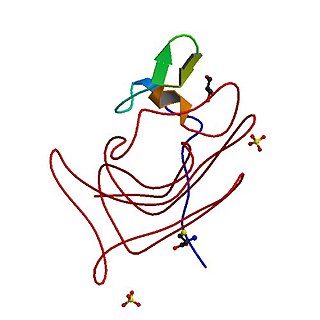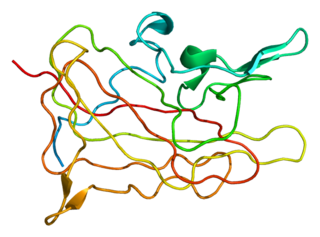Related Research Articles

Haemophilia, or hemophilia, is a mostly inherited genetic disorder that impairs the body's ability to make blood clots, a process needed to stop bleeding. This results in people bleeding for a longer time after an injury, easy bruising, and an increased risk of bleeding inside joints or the brain. Those with a mild case of the disease may have symptoms only after an accident or during surgery. Bleeding into a joint can result in permanent damage while bleeding in the brain can result in long term headaches, seizures, or a decreased level of consciousness.

Haemophilia A is a blood clotting disorder caused by a genetic deficiency in clotting factor VIII, thereby resulting in significant susceptibility to bleeding, both internally and externally. This condition occurs almost exclusively is in males born to carrier mothers due to X-linked recessive inheritance. Nevertheless, rare isolated cases do emerge from de novo (spontaneous) mutations.

Haemophilia B, also spelled hemophilia B, is a blood clotting disorder causing easy bruising and bleeding due to an inherited mutation of the gene for factor IX, and resulting in a deficiency of factor IX. It is less common than factor VIII deficiency.
Drotrecogin alfa (activated) (Xigris, marketed by Eli Lilly and Company) is a recombinant form of human activated protein C that has anti-thrombotic, anti-inflammatory, and profibrinolytic properties. Drotrecogin alpha (activated) belongs to the class of serine proteases. Drotrecogin alfa has not been found to improve outcomes in people with severe sepsis. The manufacturer's aggressive strategies in marketing its use in severe sepsis have been criticized. On October 25, 2011, Eli Lilly & Co. withdrew Xigris from the market after a major study showed no efficacy for the treatment of sepsis.
Pegfilgrastim, sold under the brand name Neulasta among others, is a PEGylated form of the recombinant human granulocyte colony-stimulating factor (GCSF) analog filgrastim. It serves to stimulate the production of white blood cells (neutrophils). Pegfilgrastim was developed by Amgen.

Factor VIII is a medication used to treat and prevent bleeding in people with hemophilia A and other causes of low factor VIII. Certain preparations may also be used in those with von Willebrand's disease. It is given by slow injection into a vein.

CSL Behring is a biopharmaceutical company, manufacturing plasma-derived, and recombination therapeutic products. The company is a combination of Behringwerke, founded in 1904 in Marburg, Germany by Emil von Behring, and the Commonwealth Serum Laboratories (CSL), established in Australia in 1916 to provide vaccines to the people of Australia, as well as other companies acquired since 2004
Moroctocog alfa is a recombinant antihemophilic factor genetically engineered from Chinese hamster ovary (CHO) cell line. Chemically it is a glycoprotein. It is manufactured by Genetics Institute, Inc. and used to control and prevent hemorrhagic bleeding and prophylaxis associated with surgery or to reduce the number of spontaneous bleeding episodes in patients with hemophilia A. It is partially a recombinant coagulation factor VIII since it has an amino acid sequence which compares to the 90 + 80 kDa form of factor VIII (BDDrFVIII). It also has posttranslational modifications which are similar to those of the plasma-derived molecule. It can not prevent hemorrhagic bleeding associated with von Willebrand's disease since it is not a von Willebrand factor.
Recombinant factor VIIa also known as eptacog alfa (INN), and sold under the brand name Novoseven among others, is a form of blood factor VII that has been manufactured via recombinant technology. It is administered via an injection into a vein.
Turoctocog alfa is a recombinant antihemophilic factor VIII used for the treatment of and prophylaxis of bleeding patients with haemophilia A. It is marketed by Novo Nordisk. It was approved in the United States, the European Union, and Japan in 2013.
Sebelipase alfa, sold under the brand name Kanuma, is a recombinant form of the enzyme lysosomal acid lipase (LAL) that is used as a medication for the treatment of lysosomal acid lipase deficiency (LAL-D). It is administered via intraveneous infusion. It was approved for medical use in the European Union and in the United States in 2015.
Luspatercept, sold under the brand name Reblozyl, is a medication used for the treatment of anemia in beta thalassemia and myelodysplastic syndromes.
Susoctocog alfa, sold under the brand name Obizur, is a medication used for the treatment of bleeding episodes in adults with acquired haemophilia, a bleeding disorder caused by the spontaneous development of antibodies that inactivate factor VIII.
Vonicog alfa, sold under the brand names Vonvendi and Veyvondi, is a medication used to control bleeding in adults with von Willebrand disease. It is a recombinant von Willebrand factor.

Pemigatinib, sold under the brand name Pemazyre, is an anti-cancer medication used for the treatment of bile duct cancer (cholangiocarcinoma). Pemigatinib works by blocking FGFR2 in tumor cells to prevent them from growing and spreading.
Pralsetinib, sold under the brand name Gavreto, is a medication approved for RET mutation-positive medullary thyroid cancer (MTC) and RET fusion-positive differentiated thyroid cancer (DTC) refractory to radioactive iodine (RAI) therapy. Pralsetinib is a tyrosine kinase inhibitor. It is taken by mouth.
Damoctocog alfa pegol, sold under the brand name Jivi is a recombinant DNA-derived, Factor VIII concentrate medication used to treat hemophilia A.
Valoctocogene roxaparvovec, sold under the brand name Roctavian, is a gene therapy used for the treatment of hemophilia A. It was developed by BioMarin Pharmaceutical. Valoctocogene roxaparvovec is made of a virus (AAV5) that has been modified to contain the gene for factor VIII, which is lacking in people with hemophilia A. It is an adeno-associated virus vector-based gene therapy. It is given by intravenous infusion.
Efanesoctocog alfa, sold under the brand name Altuviiio, is a medication used for the treatment of hemophilia A.
Concizumab, sold under the brand name Alhemo, is a monoclonal antibody used for the treatment of hemophilia B. It is an anti-tissue factor pathway inhibitor.
References
- 1 2 "AusPAR: Efmoroctocog alfa (rhu)". Therapeutic Goods Administration (TGA). 21 June 2022. Archived from the original on 19 April 2023. Retrieved 28 April 2023.
- ↑ "Prescription medicines: registration of new chemical entities in Australia, 2014". Therapeutic Goods Administration (TGA). 21 June 2022. Archived from the original on 10 April 2023. Retrieved 10 April 2023.
- ↑ "Archived copy" (PDF). Archived (PDF) from the original on 11 April 2023. Retrieved 11 April 2023.
{{cite web}}: CS1 maint: archived copy as title (link) - ↑ "Elocta 1000 IU powder and solvent for solution for injection - Summary of Product Characteristics (SmPC)". (emc). Archived from the original on 28 October 2020. Retrieved 3 September 2020.
- 1 2 3 4 5 "Eloctate (antihemophilic factor- recombinant, fc fusion protein kit". DailyMed. 4 August 2020. Archived from the original on 29 October 2020. Retrieved 3 September 2020.
- 1 2 3 4 5 "Elocta EPAR". European Medicines Agency (EMA). Archived from the original on 5 August 2020. Retrieved 3 September 2020.
- ↑ Frampton JE (November 2021). "Efmoroctocog Alfa: A Review in Haemophilia A". Drugs. 81 (17): 2035–2046. doi:10.1007/s40265-021-01615-w. PMC 8636404 . PMID 34743314.
- ↑ "June 6, 2014 Approval Letter- Eloctate". U.S. Food and Drug Administration (FDA). 6 June 2014. Archived from the original on 23 July 2017. Retrieved 3 September 2020.
- ↑ "Eloctate". U.S. Food and Drug Administration (FDA). 22 July 2017. STN: BL 125487. Archived from the original on 29 November 2020. Retrieved 3 September 2020.
 This article incorporates text from this source, which is in the public domain .
This article incorporates text from this source, which is in the public domain .